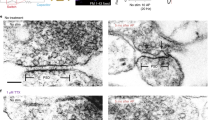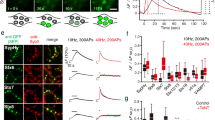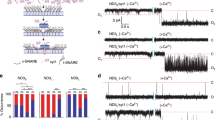Abstract
Vesicle fusion and recycling are particularly critical for ongoing neurotransmitter release1,2,3,4 in the small nerve terminals of the brain, which typically contain about 30 functional vesicles4,5. However, the modes of exocytosis and endocytosis that operate at synapses of the central nervous system are incompletely understood. Here we show real-time visualization of a single vesicle fusing at a small synapse of the central nervous system, made possible by highly intensified charge-coupled device imaging of hippocampal synaptic terminals, in which a single vesicle was labelled with the fluorescent membrane marker FM1-43 (ref. 6). In a small number of cases, full loss of fluorescent membrane dye was elicited by a single action potential, consistent with classical complete collapse1. In most cases, however, action potentials triggered only partial loss of fluorescence, suggesting vesicular retention of membrane marker, consistent with ‘kiss-and-run’ vesicle cycling3,4,7,8,9. An alternative hypothesis of independent fusion of partially stained vesicles arising from endosomal splitting could be excluded by observations on the size and timing of successive fusion events. Thus, our experimental evidence supports a predominance of kiss-and-run fusion events10,11,12 and rapid vesicular re-use11.
This is a preview of subscription content, access via your institution
Access options
Subscribe to this journal
Receive 51 print issues and online access
$199.00 per year
only $3.90 per issue
Buy this article
- Purchase on Springer Link
- Instant access to full article PDF
Prices may be subject to local taxes which are calculated during checkout




Similar content being viewed by others
References
Heuser, J. E. & Reese, T. S. Evidence for recycling of synaptic vesicle membrane during transmitter release at the frog neuromuscular junction. J. Cell Biol. 57, 315–344 (1973)
Cremona, O. & De Camilli, P. Synaptic vesicle endocytosis. Curr. Opin. Neurobiol. 7, 323–330 (1997)
Sudhof, T. C. The synaptic vesicle cycle revisited. Neuron 28, 317–320 (2000)
Harata, N. et al. Limited numbers of recycling vesicles in small CNS nerve terminals: implications for neural signaling and vesicular cycling. Trends Neurosci. 24, 637–643 (2001)
Murthy, V. N. & Stevens, C. F. Reversal of synaptic vesicle docking at central synapses. Nature Neurosci. 2, 503–507 (1999)
Cochilla, A. J., Angleson, J. K. & Betz, W. J. Monitoring secretory membrane with FM1-43 fluorescence. Annu. Rev. Neurosci. 22, 1–10 (1999)
Ceccarelli, B., Hurlbut, W. P. & Mauro, A. Turnover of transmitter and synaptic vesicles at the frog neuromuscular junction. J. Cell Biol. 57, 499–524 (1973)
Palfrey, H. C. & Artalejo, C. R. Vesicle recycling revisited: rapid endocytosis may be the first step. Neuroscience 83, 969–989 (1998)
Stevens, C. F. & Williams, J. H. ‘Kiss and run’ exocytosis at hippocampal synapses. Proc. Natl Acad. Sci. USA 97, 12828–12833 (2000)
Klingauf, J., Kavalali, E. T. & Tsien, R. W. Kinetics and regulation of fast endocytosis at hippocampal synapses. Nature 394, 581–585 (1998)
Pyle, J. L., Kavalali, E. T., Piedras-Renteria, E. S. & Tsien, R. W. Rapid reuse of readily releasable pool vesicles at hippocampal synapses. Neuron 28, 221–231 (2000)
Sara, Y., Mozhayeva, M. G., Liu, X. & Kavalali, E. T. Fast vesicle recycling supports neurotransmission during sustained stimulation at hippocampal synapses. J. Neurosci. 22, 1608–1617 (2002)
Ryan, T. A., Reuter, H. & Smith, S. J. Optical detection of a quantal presynaptic membrane turnover. Nature 388, 478–482 (1997)
Murthy, V. N. & Stevens, C. F. Synaptic vesicles retain their identity through the endocytic cycle. Nature 392, 497–501 (1998)
Del Castillo, J. & Katz, B. Quantal components of the end plate potential. J. Physiol. (Lond.), 124, 560–573 (1954)
Rosenmund, C. & Stevens, C. F. Definition of the readily releasable pool of vesicles at hippocampal synapses. Neuron 16, 1197–1207 (1996)
Zenisek, D., Steyer, J. A., Feldman, M. E. & Almers, W. A membrane marker leaves synaptic vesicles in milliseconds after exocytosis in retinal bipolar cells. Neuron 35, 1085–1097 (2002)
Neves, G. & Lagnado, L. The kinetics of exocytosis and endocytosis in the synaptic terminal of goldfish retinal bipolar cells. J. Physiol. (Lond.) 515, 181–202 (1999)
Klyachko, V. A. & Jackson, M. B. Capacitance steps and fusion pores of small and large-dense-core vesicles in nerve terminals. Nature 418, 89–92 (2002)
Sun, J. Y., Wu, X. S. & Wu, L. G. Single and multiple vesicle fusion induce different rates of endocytosis at a central synapse. Nature 417, 555–559 (2002)
Stevens, C. F. & Wesseling, J. F. Identification of a novel process limiting the rate of synaptic vesicle cycling at hippocampal synapses. Neuron 24, 1017–1028 (1999)
Sankaranarayanan, S. & Ryan, T. A. Real-time measurements of vesicle-SNARE recycling in synapses of the central nervous system. Nature Cell Biol. 2, 197–204 (2000)
Malgaroli, A. & Tsien, R. W. Glutamate-induced long-term potentiation of the frequency of miniature synaptic currents in cultured hippocampal neurons. Nature 357, 134–139 (1992)
Acknowledgements
We thank R. W. Aldrich and N. Harata for critically reading the manuscript; S. J. Smith for advice; and members of the Tsien laboratory for comments. This work was supported by grants from the NIMH (R.W.T.) and the Medical Scientist Training Program (A.M.A. and J.L.P.).
Author information
Authors and Affiliations
Corresponding author
Ethics declarations
Competing interests
The authors declare that they have no competing financial interests.
Rights and permissions
About this article
Cite this article
Aravanis, A., Pyle, J. & Tsien, R. Single synaptic vesicles fusing transiently and successively without loss of identity. Nature 423, 643–647 (2003). https://doi.org/10.1038/nature01686
Received:
Accepted:
Issue Date:
DOI: https://doi.org/10.1038/nature01686
This article is cited by
-
An active tethering mechanism controls the fate of vesicles
Nature Communications (2021)
-
Amperometry methods for monitoring vesicular quantal size and regulation of exocytosis release
Pflügers Archiv - European Journal of Physiology (2018)
-
Ammonium chloride alters neuronal excitability and synaptic vesicle release
Scientific Reports (2017)
-
Spatial distribution of conductivity in a short charged nanofluidic pore
Microfluidics and Nanofluidics (2017)
-
Real-time imaging of single synaptic vesicles in live neurons
Frontiers in Biology (2016)
Comments
By submitting a comment you agree to abide by our Terms and Community Guidelines. If you find something abusive or that does not comply with our terms or guidelines please flag it as inappropriate.



